Introduction
Rolf Schlunze (Ritsumeikan Univ.)
In the post war period, managers of MNEs and global entrepreneurs have become the central actors of the internationalization of economic activities. In this symposium we discussed theoretical and methodological aspects of international business (IB) and empirical research results that include interrelations of IB with city-regions, a discussion that we wish to promote in future. The symposium (S13) “Spaces of creativity, diversity and global management” at the annual spring meeting of the Association of Japanese Geographers (AJG) was organized by Atsushi Taira (Kagawa Univ.) and Rolf D. Schlunze (Ritsumeikan Univ.) at Nippon University at Sunday, 29 March 2015, 13:00-16:00. Prof. Schlunze, co-head of the SIEM research group, gave an introduction clarifying the research aim of Spaces of International Economy and Management (SIEM). At the symposium Prof. Dr. Schlunze defined management geography as a new avenue integrating corporate and urban geography at the nexus of managerial and innovative practices within and outside global cities. The research objective of SIEM is the analysis of the socio-economic and cognitive behavior of managerial actors influencing the performance of organizations and urban entities through their cognitive knowledge and innovative practices. SIEM is an innovative, international and multidisciplinary research group created in 2007. SIEM has since continued researching the themes of managerial and innovative practices focusing on global management and entrepreneurship. SIEM has successfully built a wider community representing a spectrum of viewpoints on management geography including numerous academics and business leaders.
Presentations
Coping with global challenges: The significance of intercultural management practices
Andrew Jones (City Univ. London)
A developing body of work in economic geography, management studies and other social science disciplines has begun to focus on the social and cultural dimensions to management practices in the global economy along with the emerging key significance of ‘global managers’ to the successful internationalization of business operations by transnational corporations (TNCs). Recent research has shown that in contrast to earlier theories of firm internationalization which regarded international expansion as primarily shaped by location cost and market access factors, corporate globalization processes and outcomes within firms are strongly shaped by a range of challenges arising from the need to operate effectively in different social, cultural and institutional contexts. In this respect, the growing demand for a certain type of ‘global manager’ within TNCs has been identified: key managers who are able to operate in cross-cultural settings and are skilled in translating, interpreting, adapting and reconfiguring cultural norms, organizational forms and working practices according to the demands of local operational contexts.
This paper critically examines the emerging theories of such intercultural global managers, and argues that economic geographers and management theorists would benefits from studying the nature of the intercultural management practices that such managers undertake in TNCs. Drawing on the practice-oriented shift in north American and European economic geography, it argues that an analytical focus on the intercultural management practices of global managers within TNCs can provide a more sophisticated theoretical understanding of the way in which corporate globality is developed within firms, and also the uneven and contested nature of that development. It argues furthermore that intercultural management capacities are a key factor in shaping whether or not TNCs initiate and sustain operations in a new local or regional context, and that firms have increasingly sought to cultivate and foster intercultural management capacity as a mechanism to respond to the challenges presented by corporation globalization strategies. The paper thus proposes a conceptual framework for understanding different types of intercultural management practices in the global economy which also outlines an approach for theorising the importance and impact of these different types of intercultural practices for firm success or failure. The framework also aims to provide a provisional conceptual basis for theorising the significance of different types of intercultural practices to firms in different industry sectors.
In order to illustrate the utility of this approach, the theoretical and conceptual arguments of the paper are expanded by drawing on research case studies of North American and European firms operating in China. Making using of research into the management practices within financial and business service firms surrounding foreign investment projects centered on Hong Kong and Shanghai, the different ways in which intercultural management practices are important to these projects is examined.
Bonding and bridging creativity, innovation and entrepreneurship: A systemic approach to innovation management
Lech Suwala (Humboldt Univ. Berlin)
The meaning of Innovation and Innovation Management has been traditionally considered as a linear process internal to the firm, biased towards technological novelty, and focused on usability attributes. In the meantime, however, complex and modified creation, production, and consumption logics call for an extended view with regard to Innovation and Innovation Management in order to cope with phenomena like networks, open innovation, or the integration of consumers into economic value chains.
Against this background, the paper attempts to offer a systemic approach towards Innovation and Innovation Management. This approach aims to bond and bridge the similar, but often isolated and unconnected concepts of creativity, innovation and entrepreneurship by investigating upon (1) the different perspectives on, (2) the subtle distinction between (3) the very nature of (4) the values created through these concepts. It enables to sketch guiding principles for a holistic understanding and management of innovation (or in other words creativity in general), the identification of paradoxes and synergies within the management of creativity and the development of a hands-on modular design and blueprint for everyday challenges with this phenomenon.
The most important insights are (1) that innovation (or creativity in general) can be considered from a variety of different perspectives which have to be adequately incorporated in order to obtain a systemic management approach towards innovation. (2) The subtle distinction between these phenomena is that creativity in its narrow sense is mainly associated with the creation of meaningful originality, whereas innovation affirms first and foremost usefulness and entrepreneurship predominantly refers to valuability. (3) The nature of innovation (or creativity in general) is characterized by something with meaningful originality, which is useful and valuable at the same time, verified (by individuals or teams), validated (by communities) and selected (by markets) against a frame of reference. (4) The values that are created and have to be carefully managed within this realm are by far not only exclusively based on economic attributes, but often rely on idiosyncratic cultural and societal meanings.
Does Chinese entrepreneurs’ guanxi networking matter to business success in Japan?
Rolf Schlunze (Ritsumeikan Univ.)
Domestic markets become saturated and entrepreneurs of SMEs are increasingly under pressure to globalize their business. Although Chinese who have been educated in Japan often start their own businesses in Japan, entrepreneurial activities of ethnic Chinese in Japan remain uninvestigated. Since many difficulties exist to embed their business activities in the Japanese business environment, it is important to ask if guanxi networking among Chinese IT entrepreneurs matters also in Japan.
A few researchers have investigated Chinese business as a new phenomenon in Japan but no study exists that investigates the success practices of their managerial adjustment, preferences and networking in the Japanese business environment. Previous research shows geographic disparities of FDI in Japan and strong concentrations in Tokyo, Osaka and Nagoya of Chinese entrepreneurial activities. Mapping the Chinese companies by industrial sector we found that Chinese IT firms concentrate foremost in Tokyo. The question is what are the strategies to overcome the liability of foreignness? With a perspective on cognitive behavior in space we would like to learn how Chinese IT entrepreneurs can overcome problems that limit their entrepreneurial expansion. Networking for Japanese style teamwork and trust building must be learnt by foreign entrepreneurs before they can succeed based on superior technology. Antecedents of guanxi networking strategy including locational preferences in the corporate, market, and living environments, as well as cultural intelligence (CQ) were examined in the line of our original framework. Chinese managers registered with the Chinese Chamber of Commerce in Japan were asked to complete a questionnaire. Those who replied were also asked to cooperate with our interview survey. Their human networks were mapped and introduced as a multiple-case study on localizing, embedding and globalizing strategies.
The results let us infer that successful Chinese entrepreneurs have high levels of CQ and strong preferences in the market environment. However, their strategies differ much in terms of their preferences. Our case studies showed that localizing and globalizing can be useful strategy to overcome problems cause by a narrowing domestic market. The cases of two Chinese IT entrepreneurs will provide evidence that different preferences lead to a different networking behavior. One case confirms that in a less favorable entrepreneurial milieu it is crucial to develop guanxi with high cultural intelligence for trustful relations in the workplace and local collaboration with local clients and customers while creating innovative and competitive products and services. Another case shows that the guanxi network can be used to internationalize business and expand to new markets. To conclude, guanxi networking remains an important strategy for sustaining entrepreneurial success in Japan and the rest of the world.
Success of Japan-based North American managers: Global places of negotiations for cultural synergy
William Baber (Kyoto Univ.)
Management geography remains unclear about the geographic location of the behaviors and business success of North American managers in Japan. This survey and interview based research studies individuals to gain information about acculturation, negotiation, networking, and Cultural Intelligence (CQ) and their links to company success in Japan.
This original empirical study draws data from fifty six survey responses. A slight majority of these were the top figure of the business. These respondents were reached via a combination of Linked In messages and emails gathered from various sources. Over 1,000 individuals were contacted one or two times over the course of approximately 24 months. Survey elements come from previous efforts by SIEM, and the Cultural Intelligence (CQ) survey.
The SIEM model shows how the environments around an individual, their adjustment, and their negotiation skill impact the performance of the company. Location is investigated by noting the location individual’s location in and preference for Tokyo (a GAWC alpha tier city), Osaka (a gamma tier city), or other locations in Japan. This work confirms the four types of expatriate in Japan found previously by SIEM (Embedder, Networker, Globalizer, and Localizer) based on preferences. Further, this research identifies three types based on path dependency: marginalized, Developing, and Frozen, while confirming the Hybrid type previously found by SIEM. Further analysis must be completed to determine the impact of geography on these three newly identified types.
Overseas operations of local firms and cross-border management: A case study of Japanese local firms
Atsushi Taira (Kagawa Univ.)
This study aims to examine characteristics of the international business of small and medium-sized firms (SMFs) through a case study of Japanese local firms. Here, ‘local firms’ refer to those which have their headquarters outside the major Japanese metropolitan areas such as Tokyo and Osaka. The majority of local firms consist of SMFs. In Japan, 99 percent of firms are SMFs, making up about 70 percent of total employment. In many cases these firms make local industry complexes, or jiba sangyo in Japanese.
Such local industries in Japan have suffered from a long economic recession and globalization of economic activities. There are, however, some examples of local firms which have been surviving through expanding overseas operations and international business. Some firms have even succeeded in increasing the number of their domestic employees by returning the profits earned overseas into their headquarters in Japan.
Local firms on the island of Shikoku, the smallest island among four major islands in Japan, are not an exception. The glove-related industry in eastern Kagawa and the towel-related industry in Imabari are good examples. Both industries, agglomerated in their respective small regions, can boast over a hundred-year history and majority shares of the domestic market based on their advanced knowledge and technology. For decades these two industries have been trying hard to survive in an increasingly competitive world by making goods in large quantity in countries with low labor costs and keeping the functions of value-added product making and research and development in their home-base regions in Shikoku. Since these local firms are small or medium-sized, unlike large firms, top managers themselves frequent their overseas affiliates and customers, and make decisions quickly. Also, locals and foreign-educated relatively young persons are assigned as managers at overseas affiliates. In other words ‘hybrid’ managers on both sides play an important role in their international business operations.
Another potential are leading firms which could be a model for others in the region. Nippura is a good example. This firm, founded in 1969, is located in Miki, a suburban town of Takamatsu, Kagawa. It has developed a specialized technology to make large scale water tanks made from acrylic fibers (resin). The firm has been awarded Guinness world records. So far, the firm has produced over 300 large water tanks for zoos and aquariums not only in Japan but also for overseas market. Currently, the firm makes up about 70 percent of the world share of aquarium water tanks which are mainly produced in its domestic plants in Kagawa, Okinawa and Hyogo.
From now on, such aforementioned “collaborative competition” and “diversity” of related firms can be utilized to make local firms and local industrial complexes more competitive in the contemporary era of ever-increasing globalization and localization. Leading firms will play an important role there through cross-border management not only in terms of the county of operations but also in the types of industry.
Commentary
Sustaining overseas business ecosystems by intercultural competence nurtured in the global expat community
Kamiya Hiroo (Kanazawa Univ.)
Discussion
Prof. Hiroo Kamiya commented that international management is a new phenomenon and remains a black box to the geography society. However, from his research he learnt that lower and middle management help to sustain country-specific practices. As a result Japanese firms often succeed to apply their management systems in overseas locations. Dr. Andrew Jones interviewed lawyers in China who talked a lot of investment in grey areas and observed messy investment practices. He pointed out that operational people are often caught up into situations. However, he also observed a shift of traditional Chinese business practices to worldwide recognized legal practices. Prof. Rolf Schlunze noticed that a lack of code of conduct can be observed in many places and that in the globalizing process more transparency is needed to connect economies to the global market. Prof. Will Baber described the situation of repatriates and pointed out that international experiences are not always rewarded by headquarters and local society. He found that cases occur where international managers do not meet their potential because they fail to negotiate the restraints placed by a closed society. Thus, Prof. Schlunze discussed also the capability of society and organizations to integrate foreigners and international managers. Prof. Takatsu praised the clear methodology and results of case studies presented. SIEM employs onscreen software enabling research members to develop data that can be calculated and analyzed.
Dr. Lech Suwala wished to discuss the meaning of what we need to understand about “managers” and “management”. He encouraged everybody to discuss Ba, a spatial concept proposed by Nonaka and Takeuchi heavily applied by the management literature though not so much within geography. Prof. Atsushi Taira concluded that Japanese SMEs often value loyalty more than specialty preferring to hire people from local universities. From a geography perspective he sees ba as a place where people meet and interact with each other. Prof. Jones sees management geography as an emerging field within economic geography intersection with work in the field of management science but still needing an injection of geographical thinking. Dr. Suwala noticed that the complexity has risen and that we need to observe that beyond social spaces there are mental spaces. Dr. Jones told that there is a significant aspect of urban geography in management geography. Finally, Professor Taira concluded that the symposium was a step forward in the internationalization process of the AJG itself. SIEM encourages AJG to continuously and pro-actively supports international geographers conducting research in Japan. We expect that AJG will promote a similar symposium more visibly in coming years.
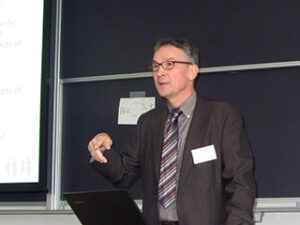 Prof. Schlunze defines Management Geography |
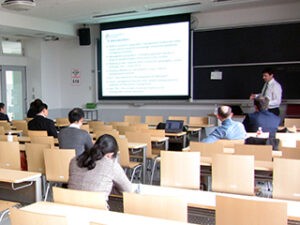 Prof. Jones reports about intercultural management practices |
|
 Dr. Suwala approaches to innovation management |
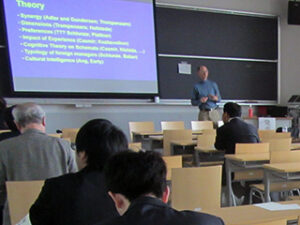 Prof. Baber spells intercultural negotiations to the audiance |
|
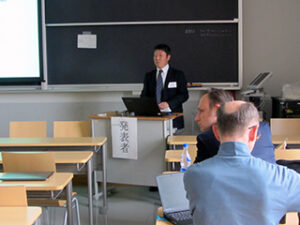 Prof. Taira presents case study research |
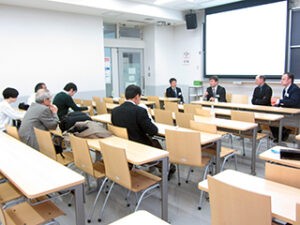 Prof. Taira chairs the panel discussion with international scholars |
